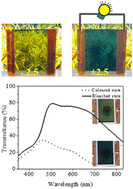Fabrication of dual-functional electrochromic smart window based on low-cost hybrid transparent electrode coated with a solution-processable polymer†
Abstract
Electrochromic smart windows are potentially promising to contribute efficiently to the power management of modern infrastructures. However, apart from a few instances, no noticeable impact of such windows is observed in the consumer market due to the high processing and material costs. Herein, a cost-effective solution is provided by utilizing a chemically synthesized conducting polymer, poly(o-methoxyaniline) (PMOANI), as an electrochromic layer over a low-cost transparent conducting electrode (ITO (60 nm)/Al-mesh) to form a smart window. The electrochromic device exhibits an excellent optical contrast of 57% between coloured and transparent states with a rapid switching ability (response time ∼5 s) and outstanding cycling stability (>500 cycles). Additionally, the energy storage capability (areal capacitance ∼8 mF cm−2) of the device confirms the dual-functionality, enabling its dark state to power a timer display for ∼20 min. The electrochromic device is made cost-effective by utilizing the concept of the hybrid electrode, where the required ITO thickness is brought down to 60 nm from 280 nm without compromising its performance. In short, the presented work demonstrates the cost-effective fabrication of a dual-functional polymeric electrochromic device, promising to replace the traditional ITO-based ones in modern infrastructures and automobile industries.



 Please wait while we load your content...
Please wait while we load your content...